Harmonic Patterns in Trading: Gartley, Crab, Bat & More 2025
Updated: 21.03.2025
Harmonic patterns: Gartley, Gartley butterfly, Crab, Bat, Shark, Three movements, ABCD and Cipher (2025)
Harmonious patterns? Hartley? So, are regular Price Action patterns no longer enough for profitable trading? Be sure to climb into such a dense forest and look for Butterflies, Crabs, Bats and Sharks there! The freebie is over, friends (if all the previous lessons could even be called freebies). Keep children and mentally unstable people away from your screens! We're starting to explore topics that will definitely get your brain racing.
It is impossible to say that only Larry Pesavento had a hand in analyzing harmonious patterns - many traders did this. One of them was Scott Carney, author of the book Harmonious Trading. It is he who owns the patterns: crab, bat and shark.
The harmonious patterns themselves are a development of the idea of geometric shapes using Fibonacci levels to more accurately determine price turning points. The main task of the patterns remains the same – determining further price movements. But the implementation of trading has changed - now patterns are not only some abstract geometric shapes on the chart, but also mathematically verified models. These patterns are based on the golden ratio (number 1.618) - it helps to find the right harmonious patterns and determine further price movement.
Harmonious patterns, unlike conventional technical analysis patterns, force the trader to wait only for perfectly formed patterns confirmed by Fibonacci levels. If a figure does not meet the ideal in some respects, then it is skipped. On the other hand, the wait is worth it - harmonious patterns show very good results during trading.
Of course, searching for these patterns does not guarantee a 100% result in every trade, but in the long run, the trader will definitely feel an increase in his deposit. As with any other trading system, it is worth paying special attention to risk management. Harmonious patterns show themselves very well in the Forex market, but there is also something to do in binary options - the profit will be less, but it will still be there.
A huge advantage of harmonious patterns is that they can be traded on any time frame. For example, on M1 or M5, the pattern will form from tens of minutes to several hours, and on daily charts, the formation of the pattern may take several months. It depends only on the trader what charts he wants to trade on. Of course, patterns on higher charts will be more reliable, but there will also be many fewer signals.
Each pattern looks like the letter M or W. The formation of a five-point pattern occurs as follows:
For example, the technical analysis pattern “Reverse Head and Shoulders” (reversal pattern) can also be a harmonic pattern. To do this, it is necessary that the head is at the 1.618 Fibonacci level from the left shoulder, and the right shoulder is at the 0.618 level from the head. This approach will greatly facilitate understanding of the figure and determine the exact entry point:
First of all, before you start searching for harmonious patterns, you need to correctly set up the Fibonacci levels - add levels such as:
The harmonious ABCD pattern is a reversal pattern, so after its formation you should expect a price reversal. Point D will indicate the end of the formation of the pattern, and will also serve as a signal to open a trade for an increase or decrease.
The key feature of the ABCD pattern is the symmetry of AB and CD. Externally, this pattern will resemble the letter “N”: There are bullish and bearish ABCD patterns. Accordingly, after a bullish pattern, you should expect a downward price reversal, and after a bearish pattern, you should expect an upward reversal. A bullish pattern has two rising highs, and a bearish pattern has two falling lows.
ABCD pattern formation:
Let's move on to practice. First of all, we find the segments ABC. We are interested in the price movement itself and the rollback to the level from 0.382 to 0.886: The BC correction ended at the level of 0.618, and the price continued its fall. Now we need to determine point D - it should form between levels from 1.13 to 2.618 from BC. But, since our correction ended at the Fibonacci level of 0.618, then, when a harmonious pattern is formed, we should expect the appearance of point D at the expansion level of 1.618 (for symmetry AB=CD): In this case, a harmonious ABCD pattern has formed, and point D appears at the level of 1.618, as expected - it is worth opening a trade up from point D.
But what if the BC correction ended at a different value? In harmonious patterns it is worth adhering to the following rules:
This is the whole point of harmonious patterns - we are looking for the right figure, with the right proportions and natural symmetry. If the figure is formed correctly, then you should count on a good profit, because the probability of a correct prediction will be high! If the formation of the figure leads to a violation of the proportions, then you should refuse to enter after the formation of point D.
The Gartley pattern itself looks like the letter "M" for a bullish pattern, and in a bearish pattern you can recognize an inverted "M" or "W". It is these formations in the form of letters that are most quickly noticed on the price chart, and only then it is worth moving on to checking and determining what kind of pattern is being formed at the moment. We find a potential pattern on the chart and proceed to confirm this pattern. Gartley includes an ABCD harmonic pattern (AB=CD), so this will make identifying the pattern on the chart a little easier. There is also an additional leg XA - the longest wave, which is directed upward in a bullish pattern and downward in a bearish pattern.
We stretch the Fibonacci grid from point X to point A - correction B should be at the level of 0.618. If this is so, then either the Gartley pattern or the Crab pattern is forming in front of us, which we will talk about a little later. Other patterns form their correction above or below the level of 0.618. The AB correction itself should never exceed point X, otherwise such patterns are false. The next step is to determine the projections (possible points of appearance) of points C and D:
A bullish pattern begins with a sharp increase in price from point X to point A, a bearish pattern, on the contrary, is characterized by a sharp drop in price from point X to point A. At point A, the direction of price movement changes to the opposite and a rollback to the Fibonacci level of 0.786 should follow: Next, we define the zones of points C and D:
Next we need to determine points C and D:
The bullish pattern of the Three Move pattern consists of a series of lower lows (downward trending price movement), while the bearish pattern, on the contrary, consists of a series of rising highs (upward trend). The essence of the “Three Moves” pattern is to look for three tops or bottoms, the last two of which will be formed within the Fibonacci levels from 1.272 to 1.618. Moreover, if the 2nd and 3rd vertices are formed at the same level, then this will be considered an ideal option: As mentioned earlier, the Three Move pattern is a reversal pattern, which means that trades will be opened against the current trend. The goal is defined as follows:
The pattern does not take into account the formation of point B, but it is very important that point D is formed approximately at levels from 0.886 to 1.13 from XA. It is also important that point C is above point A and formed at levels 1.13 – 1.618 from AB: We check point C in the following way: After the “Shark” pattern has fully formed (point D has appeared), it is worth calculating the targets (the expected strength of the price movement). To do this, stretch the Fibonacci grid from point C to point D. The nearest target will be at the level of 0.681, and the farthest one will be at the level of point C:
First, you should check point B - it should form within the Fibonacci levels from 0.382 to 0.618. Point C should form within the levels of 1.272 and 1.414 from AB (or slightly lower): Point D should be formed at the level of 0.786 from XA - after this you can open a downside trade (let me remind you, we have a bearish “Cipher” pattern). The target of the pattern should be set at the levels of points A and C:
You can download the indicator here: Download harmonic patterns indicator
For example, strong and prolonged trend movements will go unnoticed by the trader, but this could make good money. The patterns themselves, although they do not depend on the chart time frame, take a relatively long time to form. A trader needs not only an understanding of how patterns work and their correct use, but also patience.
In addition, all harmonious patterns are based on the same thing - waiting for the pattern to fully form in order to open a trade against the previous price movement. The trader must be able to identify the points at which the price turns, otherwise he will miss part of the movement and enter too late. This is another disadvantage - a trader must have a serious knowledge base in order to use harmonic patterns in his trading.
In addition to 5-6 rules for the formation of each individual pattern, you need to remember the Fibonacci levels at which the points are formed. You need to understand where the pattern begins and see its formation on the chart, but this is not so easy! I’m sure many who started reading this article were faced with a thought like “what the hell is this?!” (a familiar feeling – I experienced it myself when I first became acquainted with this topic).
To hell with these harmonic patterns - they do not form quickly and you can always have time to look at the “cheat sheet”. But how can you determine that point D has definitely formed and it’s time to act?! Use support and resistance levels? Maybe. But you need to wait for a pullback from these levels to be sure of the formation of a pattern. You can (and should) also take into account candlestick patterns or Price Action candlestick patterns – they very quickly determine price turning points, which means that it will be possible to determine the last ( and the most important) point of pattern formation almost instantly.
A novice trader will go crazy from such an abundance of information. Moreover, knowing something is one thing, but using it in practice is completely different! Of course, there will be those who will click these patterns once or twice, and their profits will flow like a river. But such traders will be in the minority, because most of those reading will not master this material the first time, and will move on to practice even later.
Of course, like any trading strategy, harmonic patterns have their own rules of construction - precise instructions for the formation of pattern points. Moreover, if the points were formed in the wrong place, then such patterns should not be used - there is a high probability of error and loss of money.
The advantages of harmonic patterns include the following:
Contents
- Harmonious patterns in trading
- Identifying harmonic patterns
- Harmonic ABCD pattern
- Gartley pattern - correct definition and use of a harmonious pattern
- Gartley Butterfly Pattern - correct definition and use of a harmonious pattern
- Crab pattern – reversal harmonious pattern
- The “Bat” pattern is a harmonic trend continuation pattern
- Three Movements Pattern - Reversal Harmonic Pattern
- Shark pattern - harmonic trend continuation pattern
- Cipher pattern or harmonious reverse butterfly pattern
- Indicators of harmonic patterns in trading
- Disadvantages of harmonic patterns in trading
- Harmonic patterns in trading: results
Harmonious patterns in trading
Harold Hartley laid the foundation for harmonious patterns in his book Profiting in the Stock Market. This book introduced the idea of a five-point pattern known as the Gartley Pattern. Later, Larry Pesavento brought this pattern to life by adding Fibonacci levels and describing the basic rules of formation in the book “Fibonacci Ratios and Pattern Recognition.”It is impossible to say that only Larry Pesavento had a hand in analyzing harmonious patterns - many traders did this. One of them was Scott Carney, author of the book Harmonious Trading. It is he who owns the patterns: crab, bat and shark.
The harmonious patterns themselves are a development of the idea of geometric shapes using Fibonacci levels to more accurately determine price turning points. The main task of the patterns remains the same – determining further price movements. But the implementation of trading has changed - now patterns are not only some abstract geometric shapes on the chart, but also mathematically verified models. These patterns are based on the golden ratio (number 1.618) - it helps to find the right harmonious patterns and determine further price movement.
Harmonious patterns, unlike conventional technical analysis patterns, force the trader to wait only for perfectly formed patterns confirmed by Fibonacci levels. If a figure does not meet the ideal in some respects, then it is skipped. On the other hand, the wait is worth it - harmonious patterns show very good results during trading.
Of course, searching for these patterns does not guarantee a 100% result in every trade, but in the long run, the trader will definitely feel an increase in his deposit. As with any other trading system, it is worth paying special attention to risk management. Harmonious patterns show themselves very well in the Forex market, but there is also something to do in binary options - the profit will be less, but it will still be there.
A huge advantage of harmonious patterns is that they can be traded on any time frame. For example, on M1 or M5, the pattern will form from tens of minutes to several hours, and on daily charts, the formation of the pattern may take several months. It depends only on the trader what charts he wants to trade on. Of course, patterns on higher charts will be more reliable, but there will also be many fewer signals.
Defining harmonic patterns
Harmonic patterns are not a simple thing and not every trader can identify them by eye. Basic harmonic patterns (butterfly, crab, bat, shark, cipher) consist of 5 key points, including the ABC or ABCD figure. Price fluctuations within a pattern are always interconnected and subject to basic harmonic coefficients.Each pattern looks like the letter M or W. The formation of a five-point pattern occurs as follows:
- X – beginning of pattern formation
- XA – first impulse wave
- AB – correction after the first wave
- BC – the second impulse wave directed in the same direction as XA
- CD – final corrective wave
For example, the technical analysis pattern “Reverse Head and Shoulders” (reversal pattern) can also be a harmonic pattern. To do this, it is necessary that the head is at the 1.618 Fibonacci level from the left shoulder, and the right shoulder is at the 0.618 level from the head. This approach will greatly facilitate understanding of the figure and determine the exact entry point:
Harmonious patterns and Fibonacci levels
Fibonacci levels are one of the main tools for identifying harmonious patterns on price charts. Personally, I use the Meta Trader 4 terminal - it has everything you need and is very convenient.First of all, before you start searching for harmonious patterns, you need to correctly set up the Fibonacci levels - add levels such as:
- 0.786
- 0.886
- 1.13
- 1.272
- 1.414
- 2.0
- 2.4
- 3.618
- 0.382 = 1 – 0.618
- 0. 786 = square root of 0.618
- 0.886 = fourth root of 0.618 or square root of 0.786
- 1.13 = fourth root of 1.618 or square root of 1.27
- 1.27 = root of 1.618
- 1.414 = root of 2
- 2 = 1 + 1
- 2.24 = root of 5
- 2.618 = square of 1.618
- 3.618 = 1 + 2.618
ABCD harmonic pattern
The harmonic ABCD pattern (or, as it is also called, AB=CD) is the simplest pattern. But I’m sure it will cause problems for you, just as it once caused me. The pattern consists of three waves: AB, BC, CD, and AB and CD are waves in the same direction, and BC is a correctional wave.The harmonious ABCD pattern is a reversal pattern, so after its formation you should expect a price reversal. Point D will indicate the end of the formation of the pattern, and will also serve as a signal to open a trade for an increase or decrease.
The key feature of the ABCD pattern is the symmetry of AB and CD. Externally, this pattern will resemble the letter “N”: There are bullish and bearish ABCD patterns. Accordingly, after a bullish pattern, you should expect a downward price reversal, and after a bearish pattern, you should expect an upward reversal. A bullish pattern has two rising highs, and a bearish pattern has two falling lows.
ABCD pattern formation:
- The pattern begins to form with the AB wave
- BC is, as a rule, a sharp correction (rollback), which is formed at Fibonacci levels from 0.382 to 0.886 from AB. Ideally – at the level of 0.618
- At point C the price turns around and moves parallel to segment AB. In this case, point D should be in the range from 1.13 to 2.618 from BC
Let's move on to practice. First of all, we find the segments ABC. We are interested in the price movement itself and the rollback to the level from 0.382 to 0.886: The BC correction ended at the level of 0.618, and the price continued its fall. Now we need to determine point D - it should form between levels from 1.13 to 2.618 from BC. But, since our correction ended at the Fibonacci level of 0.618, then, when a harmonious pattern is formed, we should expect the appearance of point D at the expansion level of 1.618 (for symmetry AB=CD): In this case, a harmonious ABCD pattern has formed, and point D appears at the level of 1.618, as expected - it is worth opening a trade up from point D.
But what if the BC correction ended at a different value? In harmonious patterns it is worth adhering to the following rules:
- With a BC correction at the level of 0.786, point D should be expected at the level of 1.272 from the BC expansion
- With a BC correction at the level of 0.886, point D should be expected at the level of 1.13 from the BC expansion
- With a BC correction at the level of 0.382, point D should be expected at the level of 2.618 from the BC expansion
- With a BC correction at the level of 0.618, point D should be expected at the level of 1.618 from the BC expansion
This is the whole point of harmonious patterns - we are looking for the right figure, with the right proportions and natural symmetry. If the figure is formed correctly, then you should count on a good profit, because the probability of a correct prediction will be high! If the formation of the figure leads to a violation of the proportions, then you should refuse to enter after the formation of point D.
How to correctly trade the harmonious ABCD pattern
Let’s summarize the harmonious ABCD pattern and identify all the most important things that were said earlier:- Visually determine three points ABC: segment AB (trend impulse) and rollback BC
- Measure the size of the correction. A pullback of the Sun should form at levels from 0.382 to levels 0.886
- We determine point D - for this it is necessary to stretch the Fibonacci grid from point B to point C so that the level at point B corresponds to the BC correction. For example, the BC correction is 0.618, which means that from point B to point C it is necessary to stretch the Fibonacci levels so that opposite point B there is a level of 0.618. Point D will be at level 1.000, forming complete symmetry
- We determine the targets for the price movement from point D. We stretch the Fibonacci levels from point A to point D. The minimum expected target will be at the level of 0.382 or 0.618. Maximum goals at the levels of point A and point C
- If possible, then place a pending deal at point D to the side, opposite the movement of CD
- For Forex: set stop loss beyond level D
Gartley pattern - correct definition and use of a harmonious pattern
The Gartley harmonic pattern is a trend continuation pattern that forms during a price correction. A bullish pattern will continue an uptrend, while a bearish pattern will continue a downtrend. The ABCD figure is a price correction against the main trend, while the entry point will also be at point D.The Gartley pattern itself looks like the letter "M" for a bullish pattern, and in a bearish pattern you can recognize an inverted "M" or "W". It is these formations in the form of letters that are most quickly noticed on the price chart, and only then it is worth moving on to checking and determining what kind of pattern is being formed at the moment. We find a potential pattern on the chart and proceed to confirm this pattern. Gartley includes an ABCD harmonic pattern (AB=CD), so this will make identifying the pattern on the chart a little easier. There is also an additional leg XA - the longest wave, which is directed upward in a bullish pattern and downward in a bearish pattern.
We stretch the Fibonacci grid from point X to point A - correction B should be at the level of 0.618. If this is so, then either the Gartley pattern or the Crab pattern is forming in front of us, which we will talk about a little later. Other patterns form their correction above or below the level of 0.618. The AB correction itself should never exceed point X, otherwise such patterns are false. The next step is to determine the projections (possible points of appearance) of points C and D:
- Point C should be within the levels 0.382 – 0.886 on the Fibonacci grid from wave AB. Point C is a turning point - the price will change its direction again. In a bullish pattern (M), there will be a decline, and in a bearish pattern (W), we should expect an increase. The ideal formation of point C can be considered its appearance at levels 0.618-0.786.
- Point D should form at levels 1.272 – 1.618 from BC. At the same time, point D should also form no higher than the level of 0.786 from the XA wave, otherwise the pattern is false. Just like point B, point D should not go beyond point X!
- XA and BC waves directed towards the main trend
- Waves AB and DC, which are waves of correction of the price movement XA
How to correctly identify and trade the Gartley pattern
Let's summarize the harmonious Gartley pattern:- We determine the emerging pattern on the chart, which will look like the letter M or the letter W
- Draw Fibonacci levels from point X to point A - point B should be at the level of 0.618
- We determine point C - it should be at a level from 0.382 to 0.886 from wave AB
- Point D should be formed at levels from 1.272 to 1.414 from BC
- Additionally, we check the correct formation of point D - we stretch the Fibonacci levels from point X to point A. Point D should be formed approximately at the level of 0.786 or lower. If this is so, then the Gartley pattern is confirmed and after the formation of point D, it is worth opening a trade in the direction of the current trend.
- For Forex: set stop loss beyond level D
Gartley Butterfly Pattern - correct definition and use of a harmonious pattern
The Gartley Butterfly pattern is a reversal pattern that allows you to determine entry points at the very beginning of a reversal of trend movements. As in other cases, a Gartley butterfly can form both in uptrends and downtrends (have a bullish and bearish formation): The Gartley butterfly is one of the most common harmonious patterns. It has earned such popularity due to the high processing of trading signals and frequent formation on price charts. The Butterfly is very similar to the Gartley and Bat pattern, but has its own characteristics.A bullish pattern begins with a sharp increase in price from point X to point A, a bearish pattern, on the contrary, is characterized by a sharp drop in price from point X to point A. At point A, the direction of price movement changes to the opposite and a rollback to the Fibonacci level of 0.786 should follow: Next, we define the zones of points C and D:
- Point C should be formed at levels 0.382 – 0.886 from wave AB
- Point D should be above (for a bearish pattern) or below (for a bullish pattern) point X and within the levels of 1.618 – 2.618 from BC. Also, point D should be formed approximately within the level of 1.272 from the XA wave
- Near target – level of point B
- Far target – level of point A
How to correctly identify and trade the harmonious Gartley Butterfly pattern
Results for the “Gartley Butterfly” pattern - a reversal harmonic pattern:- Find wave XA on the chart - a wave with a sharp drop in price (bearish pattern) or a sharp increase in price (bullish pattern)
- Point B should be formed at the level of 0.786 from wave XA
- Point C should be within levels 0.382 – 0.886 from wave AB
- Point D should be within the levels 1.618 – 2.618 from wave BC. Also, point D should be above point X and be at the level of 1.272 or below from wave XA
- The pattern is reversal, so after the formation of point D it is worth entering in the same direction where the XA movement was
- The nearest target of price movement is the level of point B, the distant target is the level of point A. After this, the pattern can be considered worked out
- For Forex: stop loss is set at level D
Crab pattern – reversal harmonious pattern
The "Crab" pattern (so named because of its long "CD" leg) is a practical copy of the Gartley butterfly. The crab is also a reversal pattern, which can be either in a bullish formation or in a bearish one (reversing the price up or down). A distinctive feature of the Crab pattern is the elongated CD leg. If in the Gartley butterfly this leg, or more precisely, point D was formed at the Fibonacci level up to 1.272 from the HA, then in the “Crab” pattern, the same leg is formed at a level up to 1.618 from the HA segment. The first thing to do is to find the beginning of the Crab pattern. It is exactly the same as the Gartley Butterfly pattern - a sharp drop in price or a sharp increase (depending on the trend). After the formation of the first knee of XA, a rollback (price correction) follows. Point B should be within the Fibonacci levels from 0.382 to 0.618.Next we need to determine points C and D:
- Point C is formed at Fibonacci levels from 0.382 to 0.618 from knee AB
- Point D is formed at levels from 2.24 to 3.618 from BC. Also, point D should be at the level of 1.618 or lower from XA
- Near target – level of point B
- Far target – level of point A
How to correctly identify and trade the harmonic pattern “Crab”
Let’s put everything together using the “Crab” harmonic pattern:- The pattern begins with a sharp drop or rise in price - leg XA
- Point B should be at levels from 0.382 to 0.618 from XA
- Point C should be within the Fibonacci levels from 0.382 to 0.886 from AB
- Point D should be at levels from 2.24 to 3.618 from BC, and also not higher than level 1.618 from HA
- Targets of the “Crab” pattern: the near target is the level of point B, the far target is the level of point A
- The trade is opened against the CD trend
- For Forex: stop loss is set at level D
The “Bat” pattern is a harmonic trend continuation pattern
The Bat pattern is very similar to the Gartley pattern. It is also formed during a price correction and indicates the continuation of the trend. The difference from the Gartley pattern is that in the Gartley point D is formed at the level of 0.786 from the XA, while in the Bat the rollback is deeper and is formed at 0.886 from the XA. In all other respects the patterns are similar. The formation of the “Bat” pattern begins with the knee HA - the longest segment in the pattern. Retracement B should be formed at Fibonacci levels from 0.382 to 0.5, and point D at levels close to 0.886: Point C is formed at levels 0.382 – 0.886 from AB. Point D should also be formed within the Fibonacci levels from 1.618 to 2.16 from BC: The pattern's goals are determined as follows: the Fibonacci grid is stretched from point A to point D. The near target is level 0.618, the distant target is the level of point A:How to trade the harmonious “Bat” pattern correctly
And so, the “Bat” pattern:- Movement HA – the longest and most sustained movement in the pattern
- Point B should be at levels 0.382 – 0.5 from XA
- Point C should be at levels 0.382 – 0.886 from AB
- Point D is formed at levels from 1.618 to 2.618 from BC. Also, point D should not be higher than the level of 0.886 from XA
- The targets of the “Bat” pattern are as follows: the near target is the level 0.618 from AD, the far target is the level of point A
- The trade is opened at point D in the same direction as the price movement during the formation of the XA knee
- For Forex: stop loss is set at level A
Three Movements Pattern - Reversal Harmonic Pattern
The Three Movements pattern is based on Elliot wave theory. This pattern differs from the others in that it does not have an ABCD figure in its formation, but consists of three trend tops or three trend bottoms, forming five knees.The bullish pattern of the Three Move pattern consists of a series of lower lows (downward trending price movement), while the bearish pattern, on the contrary, consists of a series of rising highs (upward trend). The essence of the “Three Moves” pattern is to look for three tops or bottoms, the last two of which will be formed within the Fibonacci levels from 1.272 to 1.618. Moreover, if the 2nd and 3rd vertices are formed at the same level, then this will be considered an ideal option: As mentioned earlier, the Three Move pattern is a reversal pattern, which means that trades will be opened against the current trend. The goal is defined as follows:
- If the pattern is bullish, then the Fibonacci grid is stretched from the highest point of the pattern to the lowest point. The near target is level 0.618, the far target is level “1.0”
- If the pattern is bearish, then the Fibonacci grid is stretched from the lowest point of the pattern to the highest point. The near target is level 0.618, the far target is level “1.0”
How to correctly trade the harmonious pattern “Three movements”
Three Movements Pattern:- The formation of a bullish pattern occurs in a downtrend - each new top and bottom is lower than the previous one
- The formation of a bearish pattern occurs in an uptrend - new local highs and lows are higher than the previous ones
- Troughs or tops 2 and 3 must be formed within Fibonacci levels from 1.272 to 1.618 from their corrections
- The purpose of the “Three Movements” pattern: from the beginning of the pattern to the 3rd top or bottom, Fibonacci levels are extended. The near target is level 0.618, the far target is level 1.0
- Transactions are opened against the current trend (the pattern is a reversal)
- For Forex: set stop loss beyond the third local minimum or maximum
Shark pattern – harmonic trend continuation pattern
The Shark pattern is an expanding triangle, which is the easiest way to find it on a price chart. The pattern itself is a signal to continue the trend. The entry point, as usual, is after the formation of point D. It is also worth noting that in this pattern, point C is above point A, and point D is below point X (in a bullish pattern formation).The pattern does not take into account the formation of point B, but it is very important that point D is formed approximately at levels from 0.886 to 1.13 from XA. It is also important that point C is above point A and formed at levels 1.13 – 1.618 from AB: We check point C in the following way: After the “Shark” pattern has fully formed (point D has appeared), it is worth calculating the targets (the expected strength of the price movement). To do this, stretch the Fibonacci grid from point C to point D. The nearest target will be at the level of 0.681, and the farthest one will be at the level of point C:
How to trade the Shark pattern correctly
Let's collect all the rules for trading the Shark pattern:- The pattern is an expanding triangle
- It is important that point D be formed at Fibonacci levels from 0.886 to 1.13 from XA
- Point C should be at levels from 1.13 to 1.618 from AB (i.e. above point A)
- The target of the “Shark” pattern is determined by the Fibonacci levels - they stretch from point C to point D. The near target is the level of 0.618, the far target is the level of point C.
- The trade is opened after the formation of point D in the direction of the formation of the knee XA
- For Forex: stop loss is set at level D
“Cipher” pattern or harmonious “reverse Butterfly” pattern
The Cipher pattern is often called the reverse Butterfly. The patterns differ in that the change in the main price direction occurs not at point C, but at point X - the entire pattern is formed in one trend and is a pattern of continuation of the trend trend. The “Cipher” pattern allows you to find a good entry point in an already formed trend: The Cipher pattern is very often formed at the beginning of trend movements: The HA movement is the longest movement, which was one of the first to form in a new downward trend. We have a bearish formation ahead of us, which means we should prepare to enter a bearish position after the “Cipher” pattern is formed.First, you should check point B - it should form within the Fibonacci levels from 0.382 to 0.618. Point C should form within the levels of 1.272 and 1.414 from AB (or slightly lower): Point D should be formed at the level of 0.786 from XA - after this you can open a downside trade (let me remind you, we have a bearish “Cipher” pattern). The target of the pattern should be set at the levels of points A and C:
How to correctly find and trade the “Cipher” pattern
Let’s summarize the “Cipher” trend continuation pattern:- As a rule, the Cipher pattern is formed at the beginning of a trend movement
- HA – the longest leg of the pattern
- Point B must be within the Fibonacci levels from 0.382 to 0.618 from XA
- Point C should be formed at levels 1.272 – 1.414 from AB (or near these levels)
- Point D is formed at levels 0.786 from XA
- The target of the “Cipher” pattern: the nearest target is the level of point A, the far target is the level of point C
- Open a trade in the direction of the current trend
- For Forex: set stop loss at level X
Indicators of harmonic patterns in trading
Let's make it easier for you. Understanding how harmonious patterns are built is great, but it is not necessary to calculate all the points manually using Fibonacci levels. There are several other ways, for example, on a live chart it is possible to draw the desired model and it will itself calculate all the necessary data on the chart: And if you are too lazy to do something yourself, then I suggest an indicator for MetaTrader4, which itself determines harmonious patterns on price charts: To be honest, I did not have time to personally try this indicator, but judging by the reviews, it works well and quite accurately determines entry points. More precisely, it determines the end of harmonious patterns, and you need to look for the entry point yourself, so don’t forget about the goals!You can download the indicator here: Download harmonic patterns indicator
Disadvantages of harmonic patterns in trading
It would seem that there may be disadvantages to harmonic patterns in trading, but they still exist. No matter how accurate the patterns are, more often than not, a trader who trades only using these patterns will miss many entry points where these patterns do not exist.For example, strong and prolonged trend movements will go unnoticed by the trader, but this could make good money. The patterns themselves, although they do not depend on the chart time frame, take a relatively long time to form. A trader needs not only an understanding of how patterns work and their correct use, but also patience.
In addition, all harmonious patterns are based on the same thing - waiting for the pattern to fully form in order to open a trade against the previous price movement. The trader must be able to identify the points at which the price turns, otherwise he will miss part of the movement and enter too late. This is another disadvantage - a trader must have a serious knowledge base in order to use harmonic patterns in his trading.
In addition to 5-6 rules for the formation of each individual pattern, you need to remember the Fibonacci levels at which the points are formed. You need to understand where the pattern begins and see its formation on the chart, but this is not so easy! I’m sure many who started reading this article were faced with a thought like “what the hell is this?!” (a familiar feeling – I experienced it myself when I first became acquainted with this topic).
To hell with these harmonic patterns - they do not form quickly and you can always have time to look at the “cheat sheet”. But how can you determine that point D has definitely formed and it’s time to act?! Use support and resistance levels? Maybe. But you need to wait for a pullback from these levels to be sure of the formation of a pattern. You can (and should) also take into account candlestick patterns or Price Action candlestick patterns – they very quickly determine price turning points, which means that it will be possible to determine the last ( and the most important) point of pattern formation almost instantly.
A novice trader will go crazy from such an abundance of information. Moreover, knowing something is one thing, but using it in practice is completely different! Of course, there will be those who will click these patterns once or twice, and their profits will flow like a river. But such traders will be in the minority, because most of those reading will not master this material the first time, and will move on to practice even later.
Harmonic patterns in trading: summary
Harmonic patterns are proof that price tends toward symmetry. This trading approach allows you to make money on seemingly chaotic price movements.Of course, like any trading strategy, harmonic patterns have their own rules of construction - precise instructions for the formation of pattern points. Moreover, if the points were formed in the wrong place, then such patterns should not be used - there is a high probability of error and loss of money.
The advantages of harmonic patterns include the following:
- High signal penetration (good win rate)
- Patterns are formed on any time frames
- In most cases, after the pattern is formed, the price moves at least to the minimum target, which means the trader always knows where it would be a good idea to stop and not open any more trades.
- Patterns work well with various technical analysis tools
- Complex pattern formation – the rules are demanding of the trader’s knowledge
- An inexperienced trader will find it difficult to find patterns on the chart
- Sometimes patterns are formed with different signals on different time frames
- Required knowledge in the work of support and resistance levels, as well as Price Action candlestick patterns for determining turning points
- Patterns are best suited for the Forex market - on binary options the profit will be less due to the long wait for patterns to form

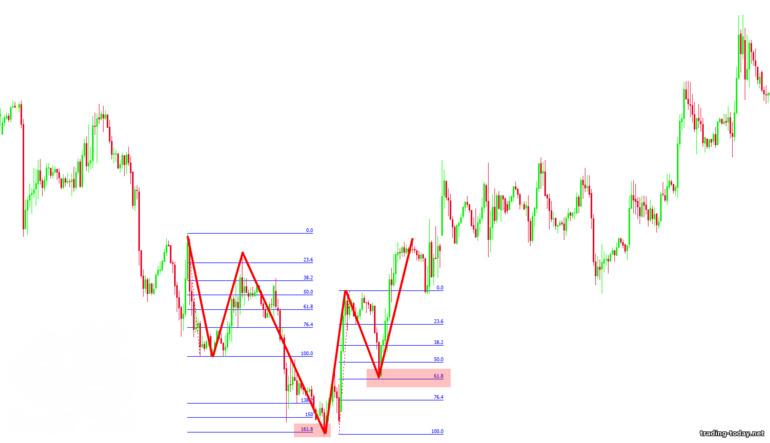
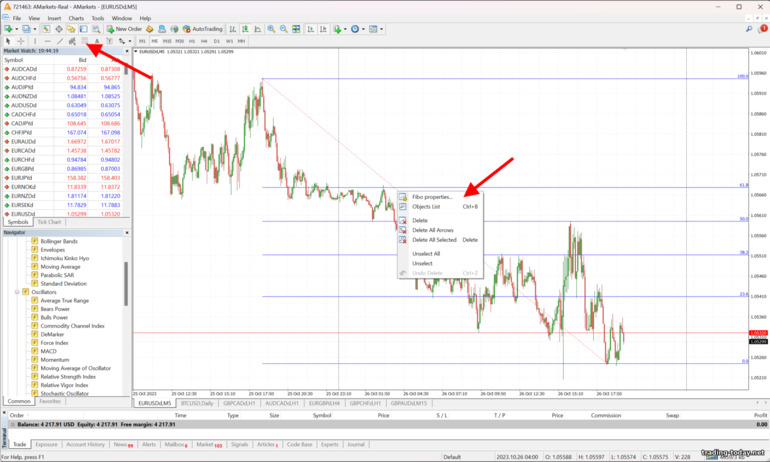

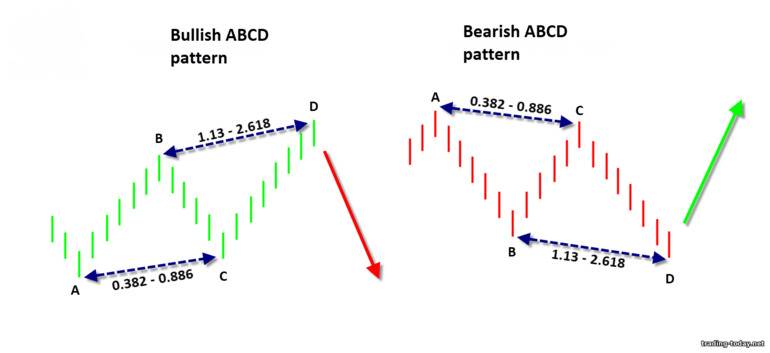

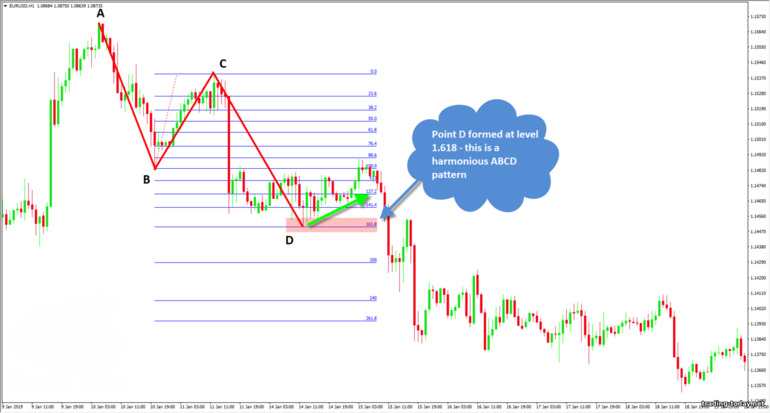
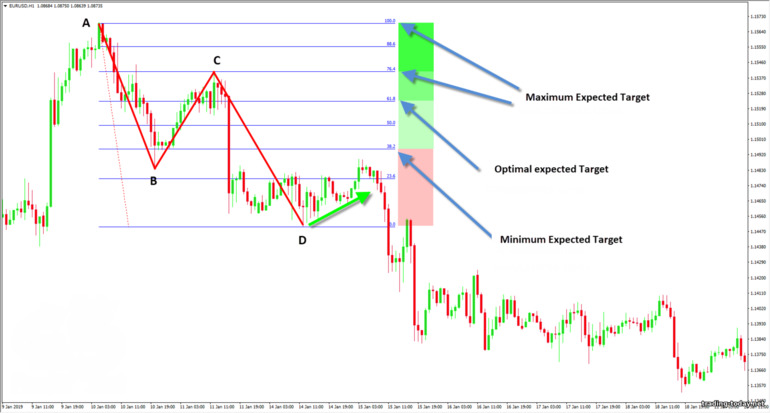
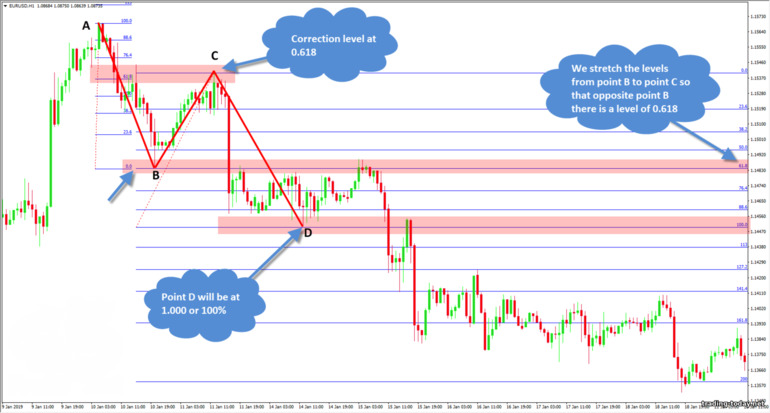
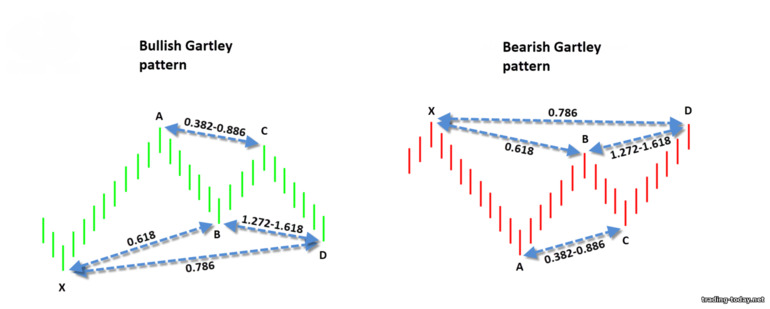
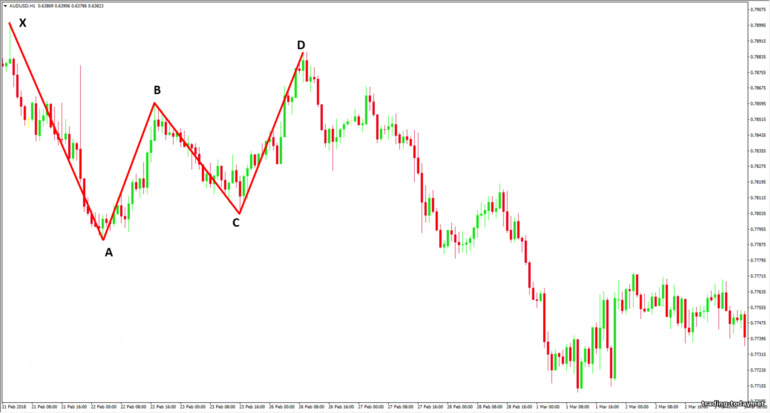
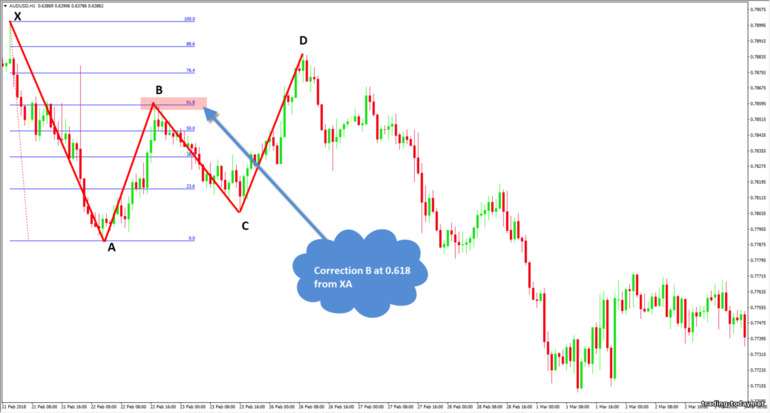
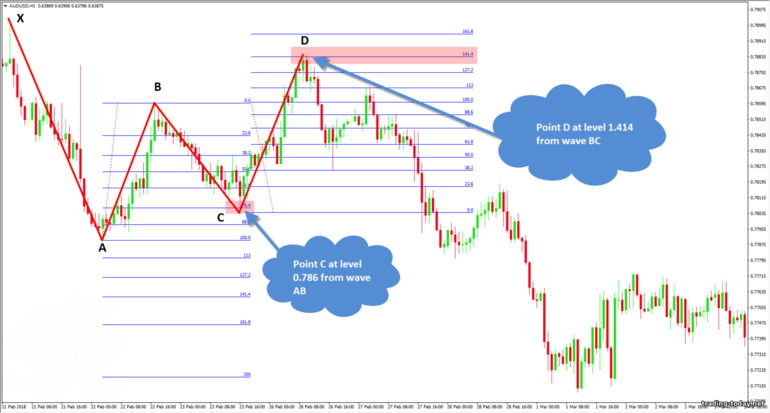
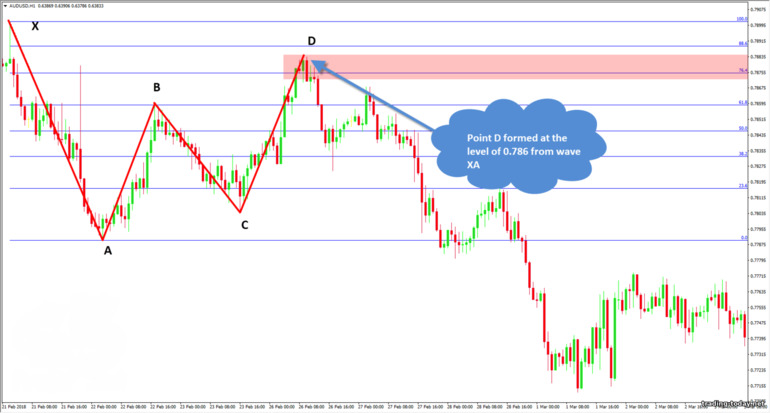
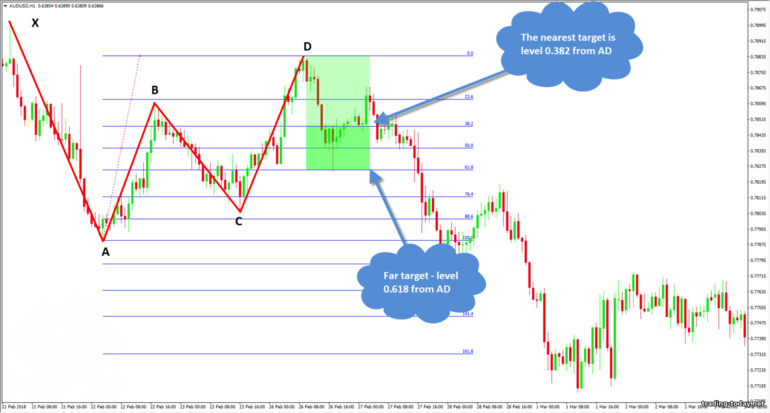
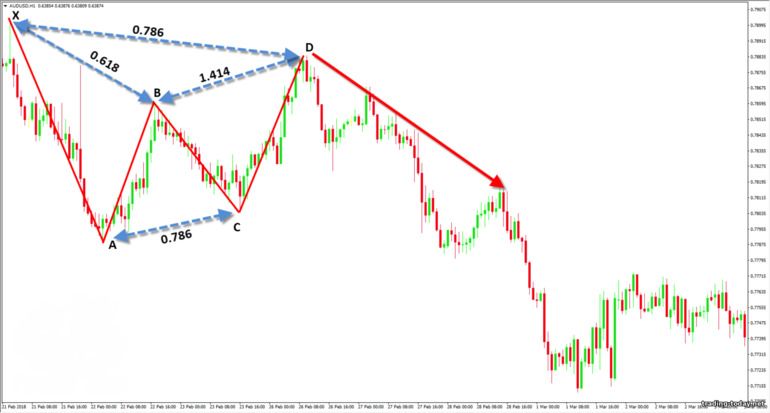
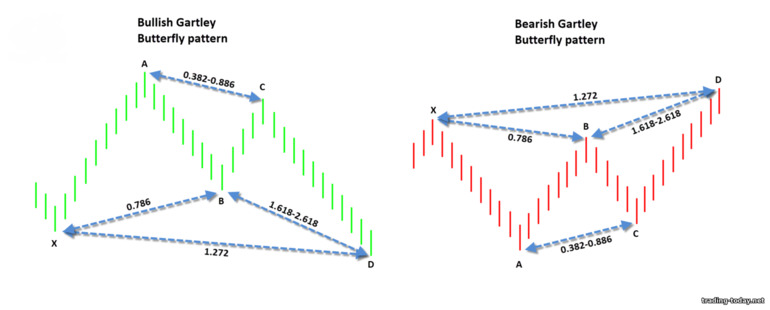
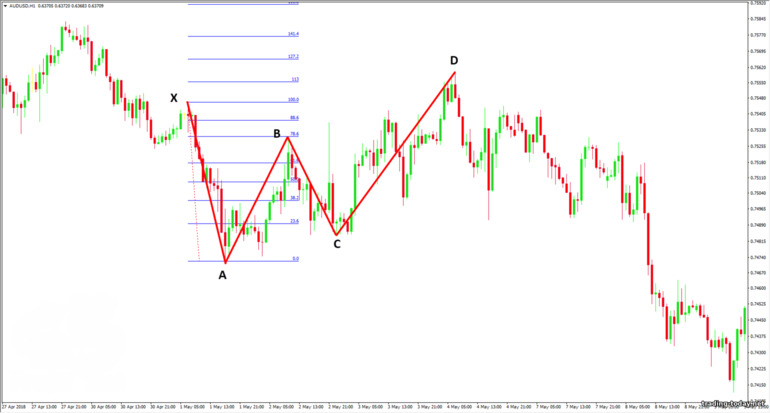
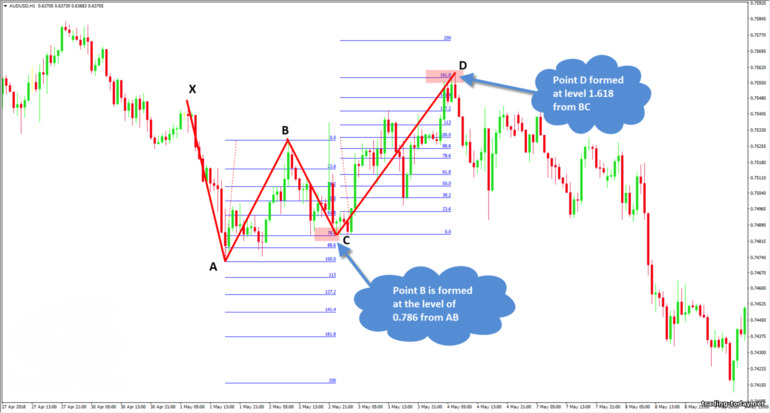
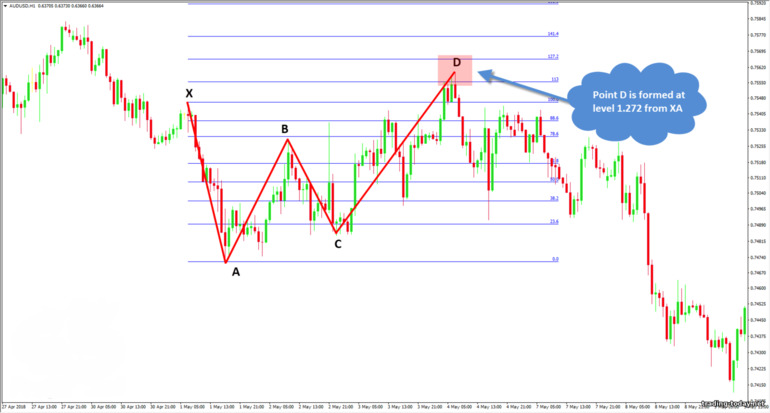
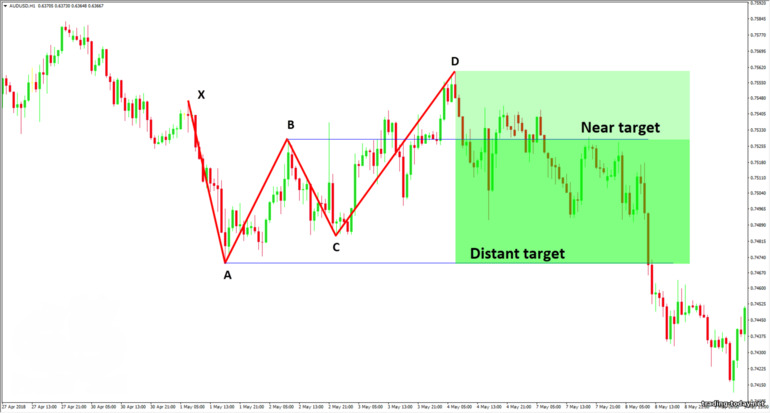
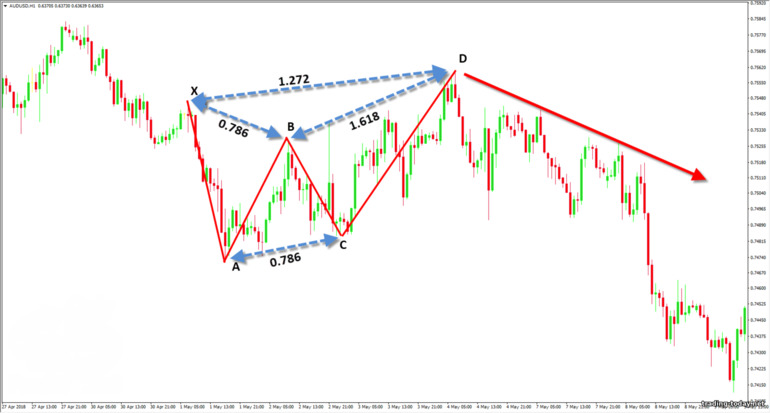
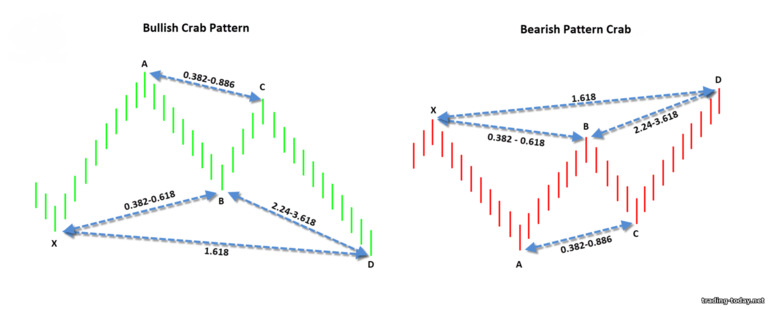
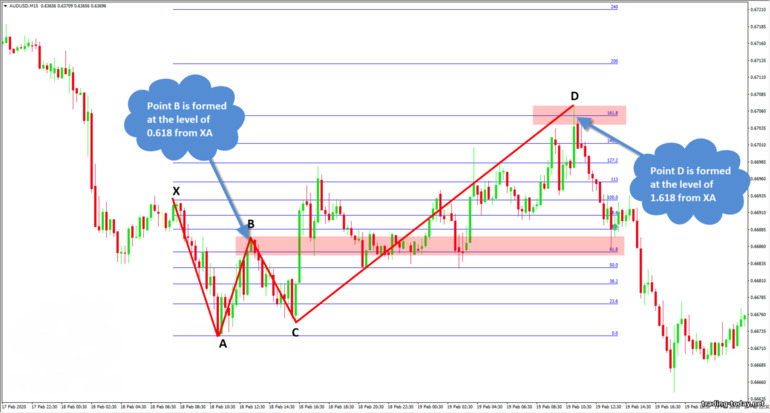
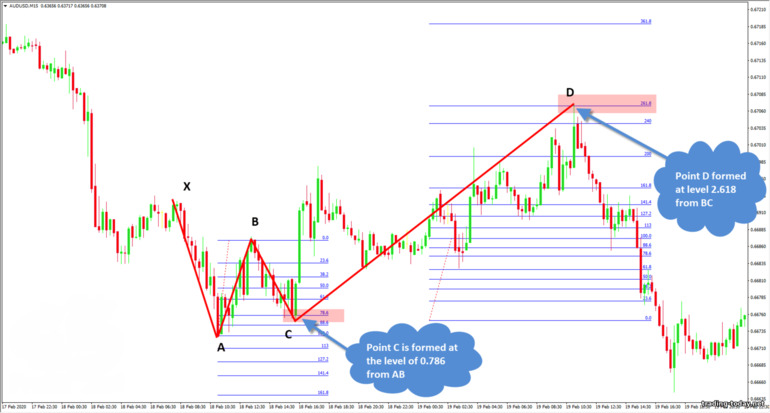
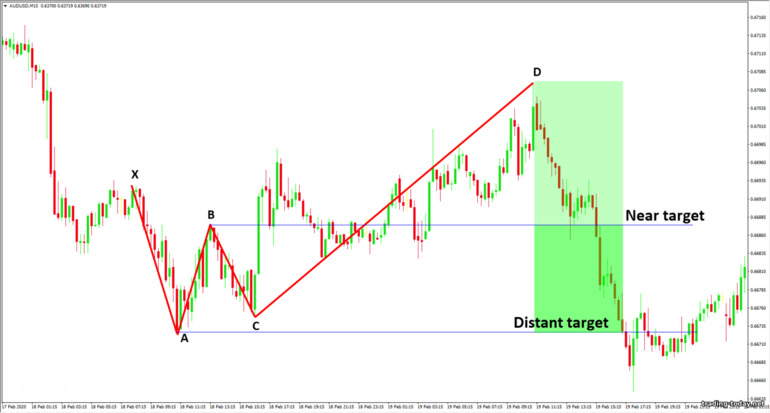
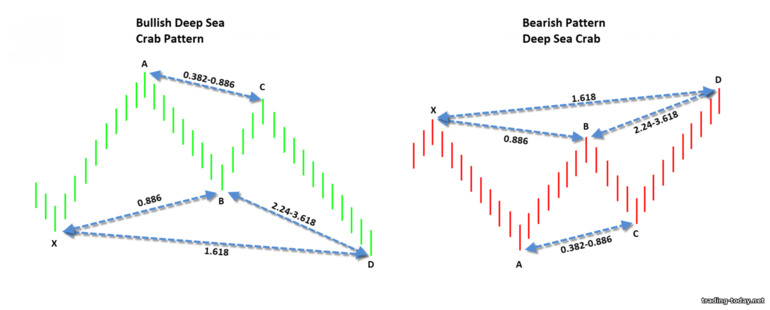
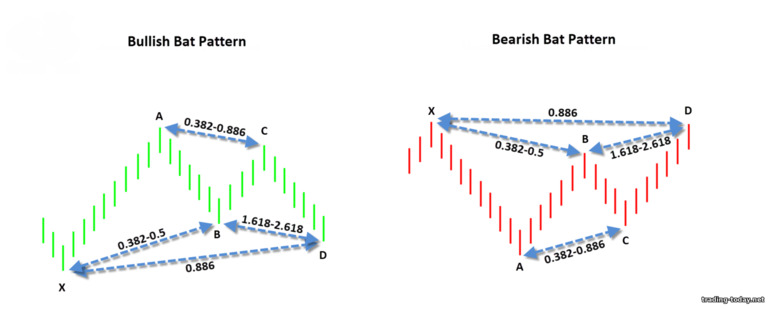
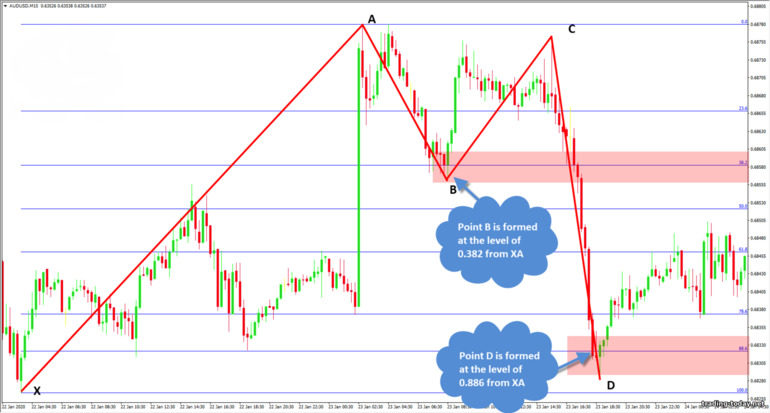
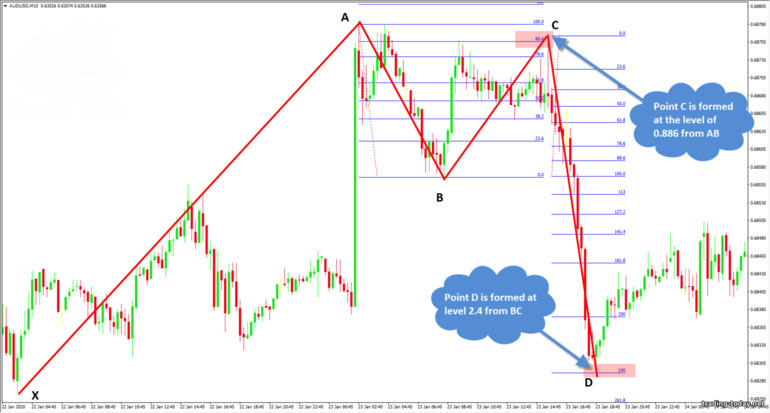
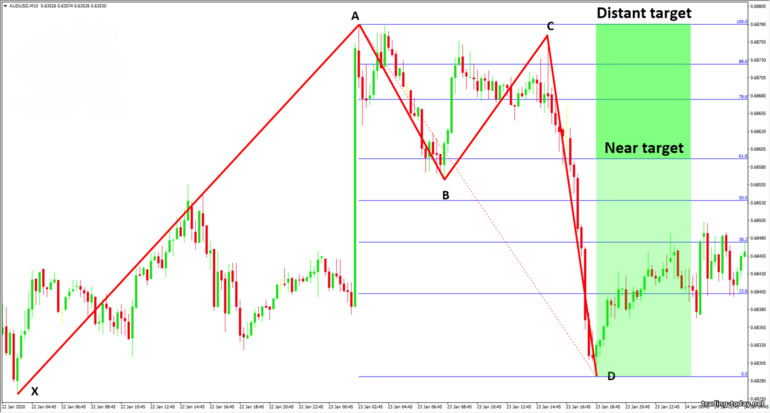
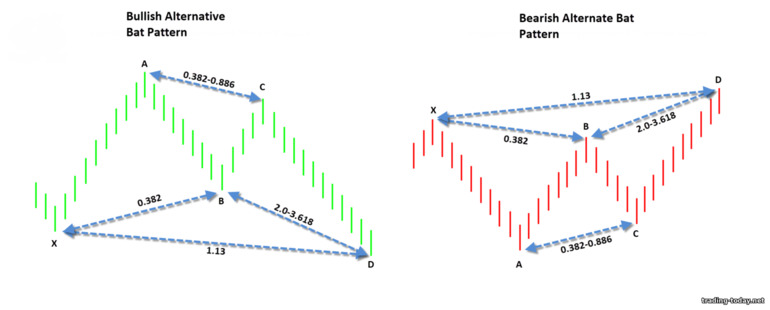
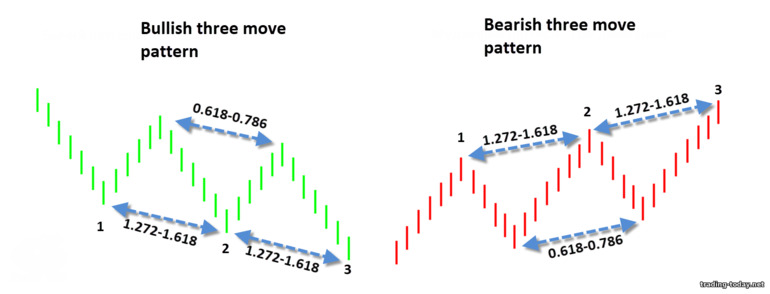

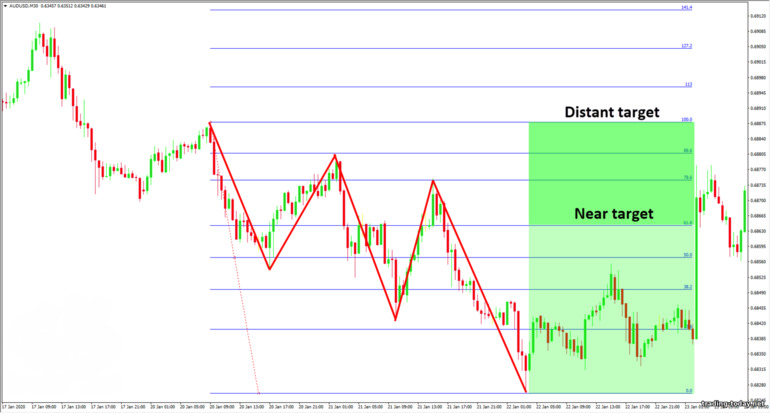
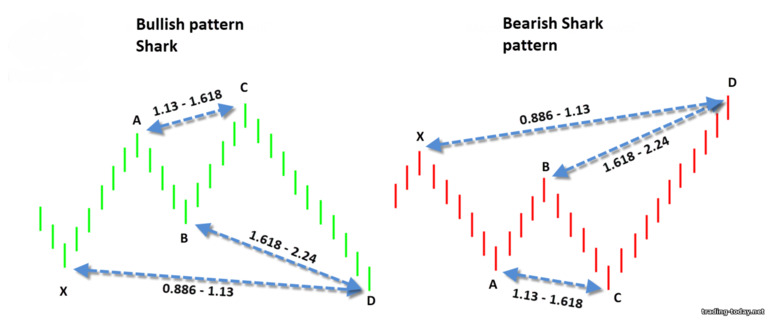
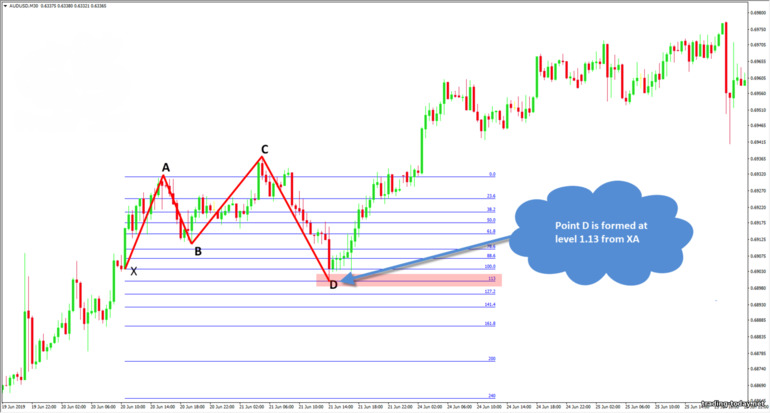
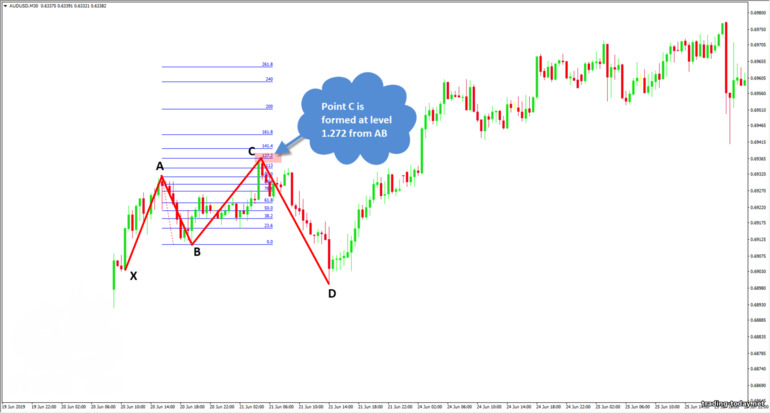
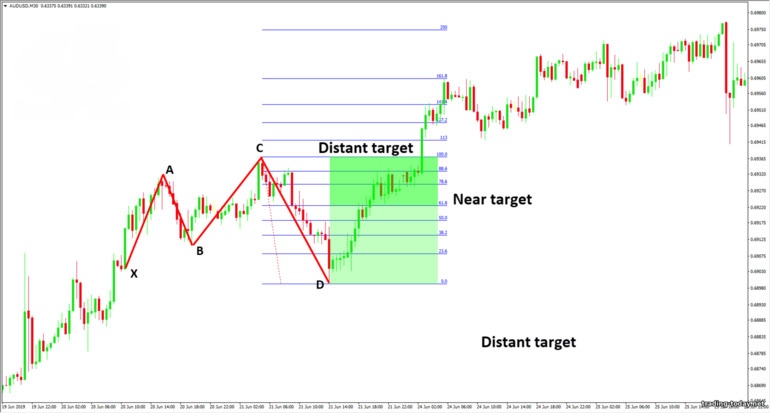
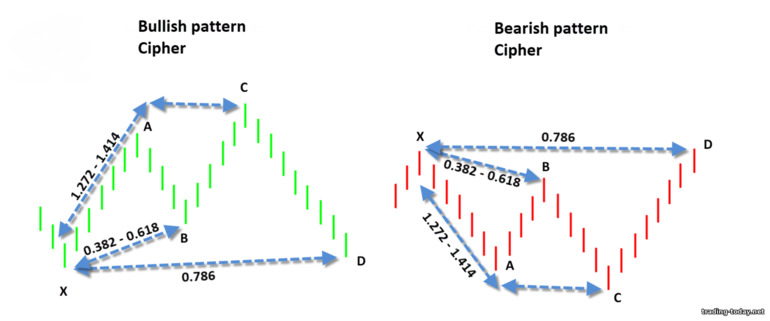
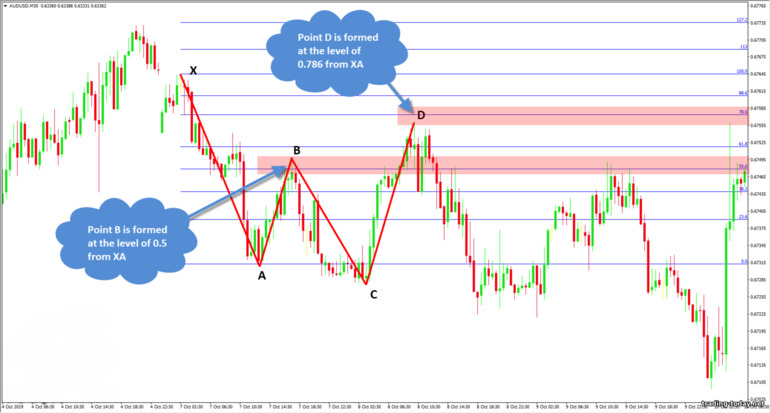
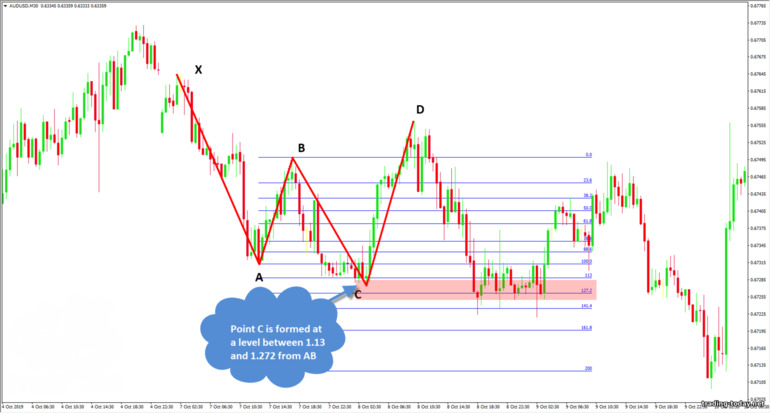
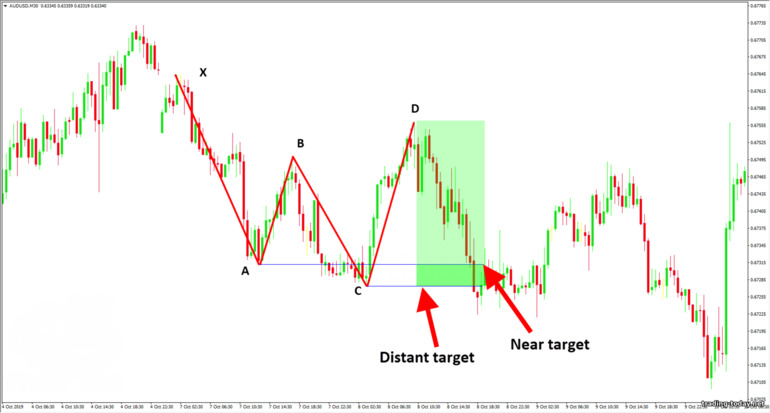
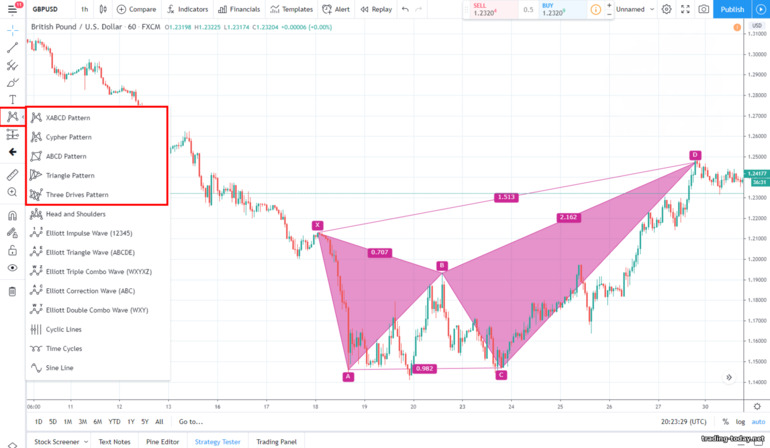
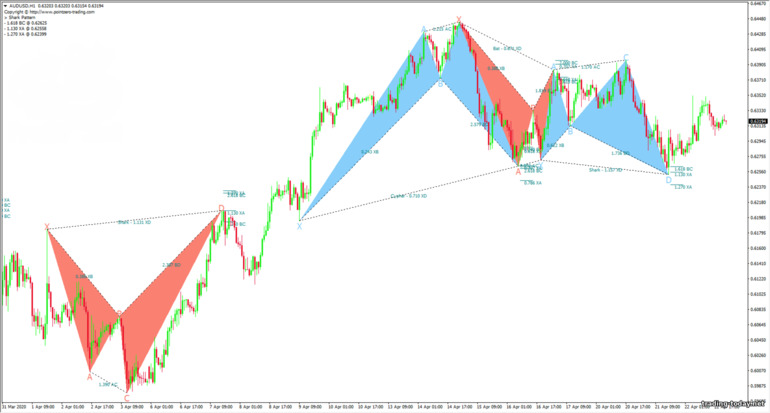

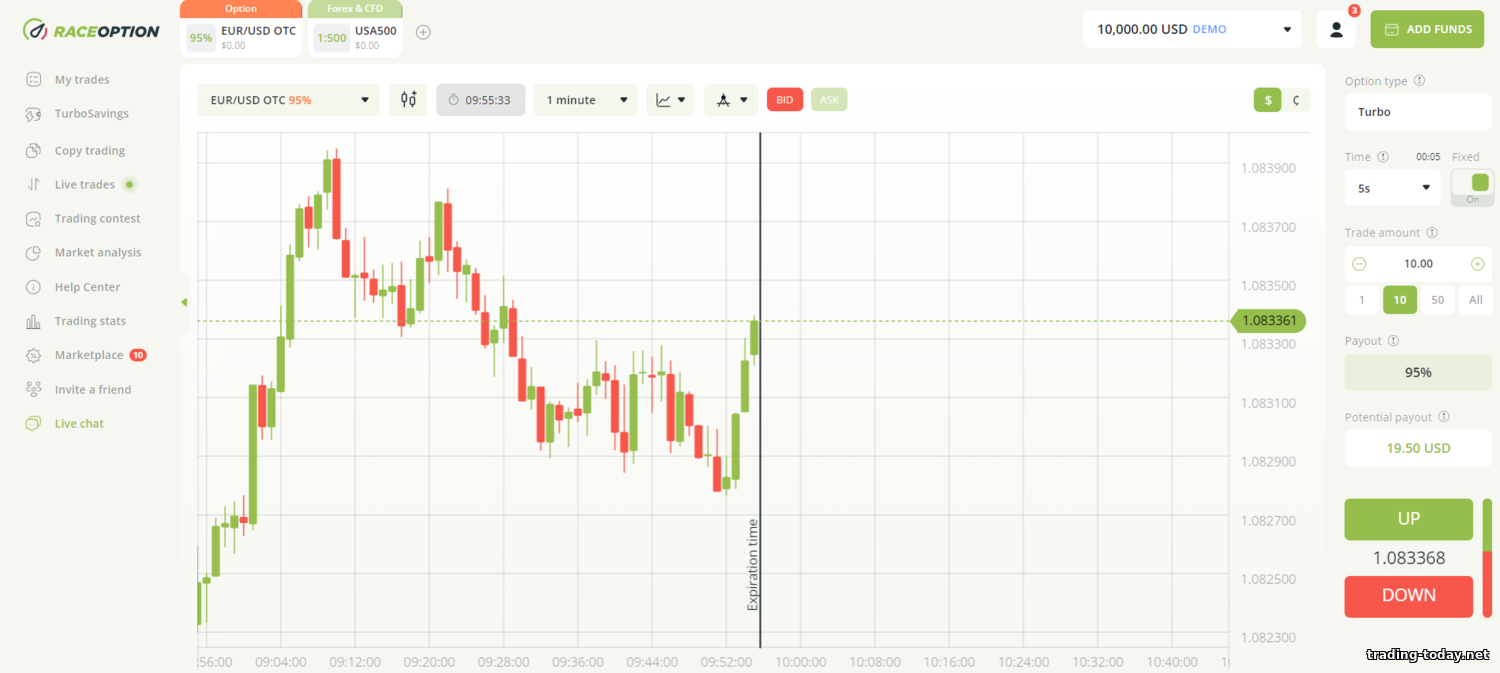
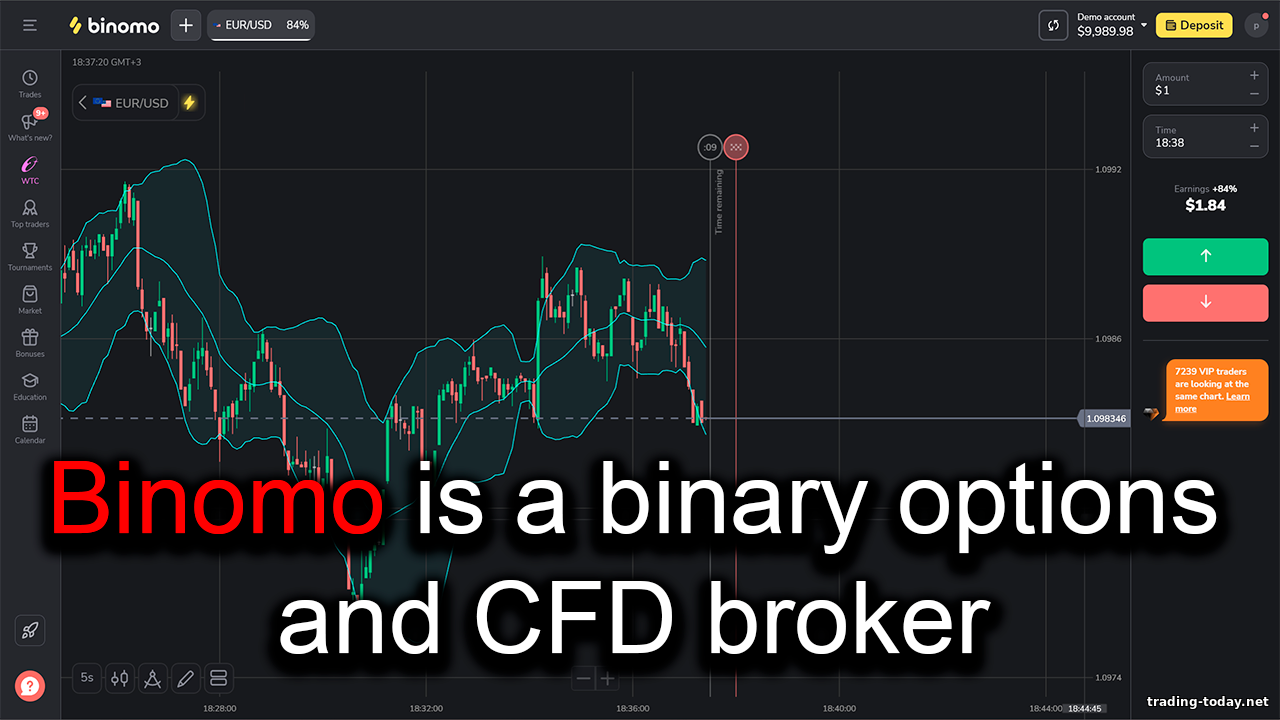




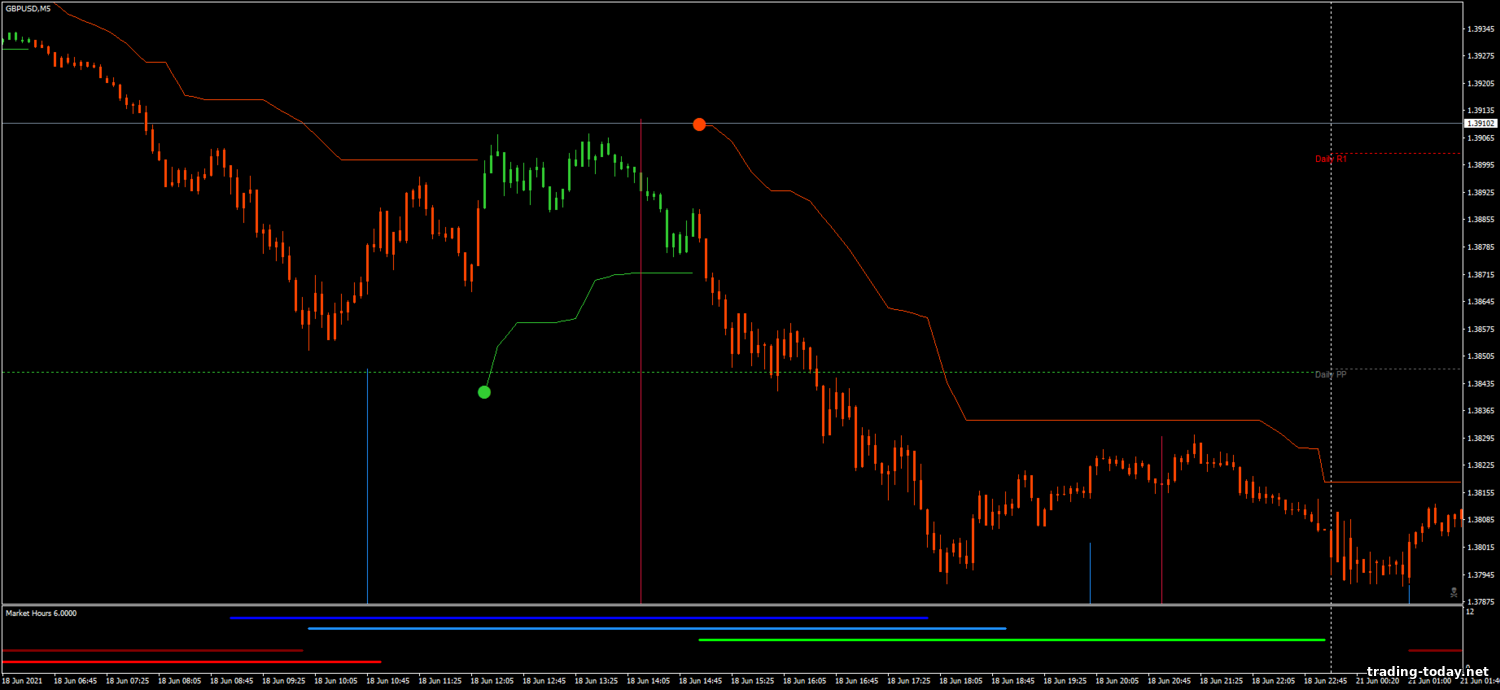
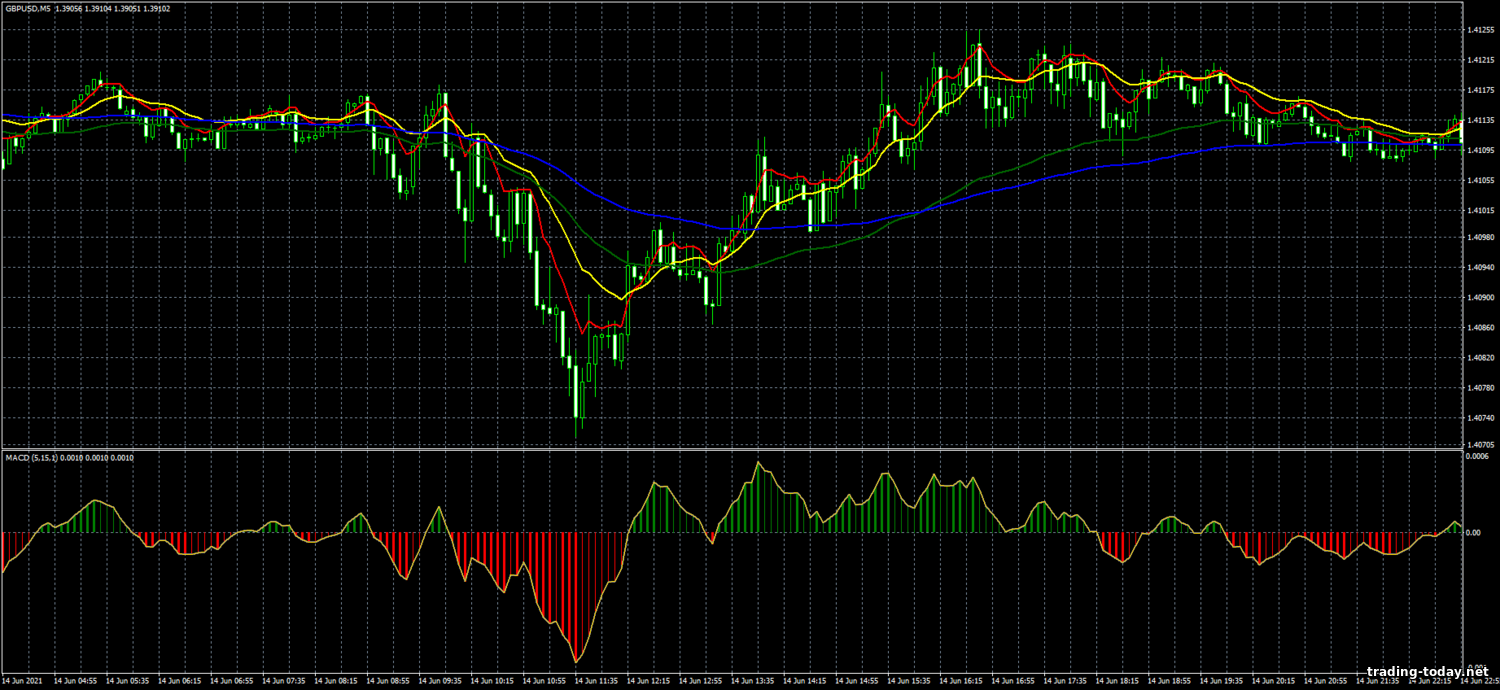
Reviews and comments